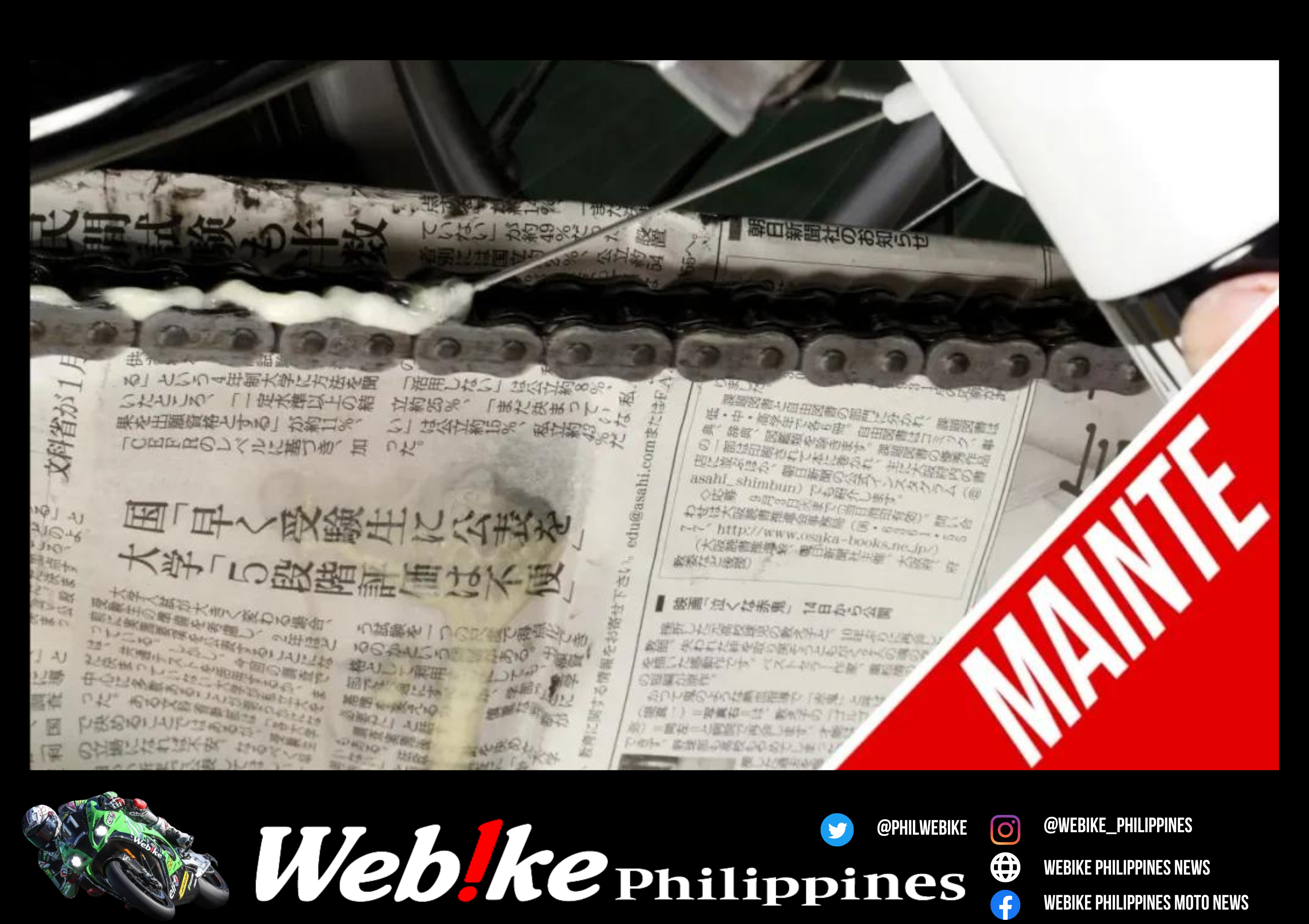Newspaper and cardboard are effective in reducing and preventing dirt on tires and wheels

Grease-like oil stains can be easily removed by lifting them up with a brush and then spraying them with chain cleaner. Use a nylon brush for the seal chain, as a metal wire brush may damage the O-rings.

Spraying chain oil with slow-drying chain cleaner still on the chain is difficult to fix (easily dispersed), so wipe it off with a rag and allow some time before applying the oil. Spraying from the outside of the plate makes it difficult to reach bushings and O-rings on the inside of the plate, so use a spray nozzle to aim at bushings. If the amount of oil applied is too small, it may not cover the entire surface, so spray without worrying about dripping onto the newspaper guide.
To prevent splattering or sticking to wheels and tires when spraying chain cleaner or chain oil, it is easy and effective to insert newspaper or cardboard at the back of the chain. In the image, the newspaper is slightly above the top of the chain, but it can be pulled up close to the swing arm if the rear tire is idled before spraying and the newspaper does not get caught.
This will increase the protective effect. Simply by placing newspaper or cardboard between the tires and wheels, the cleaner and oil will not splash onto the tires and wheels and can be sprayed without hesitation. Aside from the cleaner, chain oil splashed on the tread surface can cause slipping, so a guard that can reliably block it is a big relief. Chain cleaner, like parts cleaner, has low viscosity and is silky, so it flows off the chain as soon as it is sprayed.
Some of the dirt on the chain surface is washed away by the gas pressure of the spray, but any persistent residue should be scrubbed with a brush to float and then washed away with the cleaner. When cleaning the seal chain, use a product specifically labeled as a chain cleaner rather than general brake and parts cleaners, as some of these products contain ingredients that can damage the rubber O-rings.
The same goes for chain oil; if your bike is equipped with a sealed chain, use a product that is compatible with O-rings. Some spray-type oils can cause rubber to swell, so check the warning signs carefully before proceeding. When spraying chain oil, which has a higher viscosity than cleaner, there is a concern that it will not be sufficiently distributed to each part of the chain if only a small amount is sprayed because of concern about splashing. When cleaning with parts cleaner, the oil will run off along with the dirt, so the rollers that contact the sprocket teeth, the gaps between the rollers and bushings, and the contact surfaces between the inner and outer plates and O-rings must be lubricated with an appropriate amount of oil. In the case of a non-seal chain, direct contact between the pin and bushing, which exerts the greatest force during the ride, without lubrication causes significant wear, so lubrication with chain oil is even more important than in a sealed chain. Whether it is a sealed chain or a non-seal chain, a newspaper guard on the back side of the chain is essential when applying chain oil. As long as it is ensured that the oil does not adhere to the tires or wheels, the necessary and sufficient amount of oil can be sprayed.
There is also an attachment that can be used to focus the lubrication point for spraying.

The utility model lubricator that comes with Enuma Chien's maintenance set EK-Men features the ability to spray oil from four jets at the same time. Chain manufacturers develop such tools because they recognize the importance of lubricating rollers and plates (O-ring parts).

The lubricator does not miss the target of the lubricated area due to the guides that contact the roller and the outer plate section, along with the four spray outlets. Since the spray area is more limited than that of a normal nozzle, adhesion to wheels and tires is also reduced.
When applying chain oil, do not spray it vaguely, but aim it where it is needed. Specifically, the gap between the rollers and bushings, and the contact area between the O-rings and the plate.
As mentioned earlier, the rollers and bushings are areas where metals are in direct contact with each other, and the O-rings may be worn by rubbing against the degreased plate. To target the oil, use a nozzle to spray inside the plates of the chain, rather than spraying widely away from the chain. This will spread the oil over the plates and rollers. To apply chain oil effectively, Enuma Chien, known for its EK brand, has developed the utility model lubricator. The lubricator is an attachment to a chain oil spray can and its outlet is designed to apply the oil without wasting it.
The importance of chain lubrication can be understood from the fact that the chain manufacturer itself has developed such a special attachment.
Wipe off excess oil with a rag after lubrication to reduce splashing while riding.

Chain oil is more viscous than ordinary rust-preventive lubricants, so it takes some time to penetrate narrow gaps such as those between bushings and rollers. Wait 30 minutes after application, and then wipe off any oil still remaining on the surface with a rag. At this time, wiping the outside of the plate with oil will help prevent rust.
There are wet and dry types of chain oil, and both types require waiting 15 to 30 minutes after application to allow the oil to penetrate into each part before wiping off any oil on the surface with a rag. If the motorcycle is ridden without waiting for the oil to penetrate, the oil may not spread to the gaps between the rollers and bushings that really need lubrication, and the motorcycle may not be sufficiently lubricated. If the oil is still sticky on the surface of the chain, it can cause the chain and sprockets to become dirty from gravel and other debris that rolls up, and oil scattered by the rotating chain can adhere to the wheels, tires, swing arms, etc., causing them to become dirty and sticky. Wipe off any excess oil that remains after penetration. Since both chain cleaner and chain oil are sprayed on the chain, they will inevitably splash onto other parts of the chain. Placing newspaper or cardboard on the back side of the chain is essential preparation for a good finish, just like covering the painted area with a masking sheet when painting. Applying chain oil every few hundred kilometers is a tedious job, which is why it is recommended to use a guide to avoid contaminating the rest of the chain to reduce the clean-up time.
POINT
Point 1 - A newspaper or cardboard cover can be set on the back of the chain to spray as much chain cleaner or chain oil as needed
Point 2 - After spraying the chain oil, allow some time for it to penetrate, then wipe off any excess that remains on the surface.



